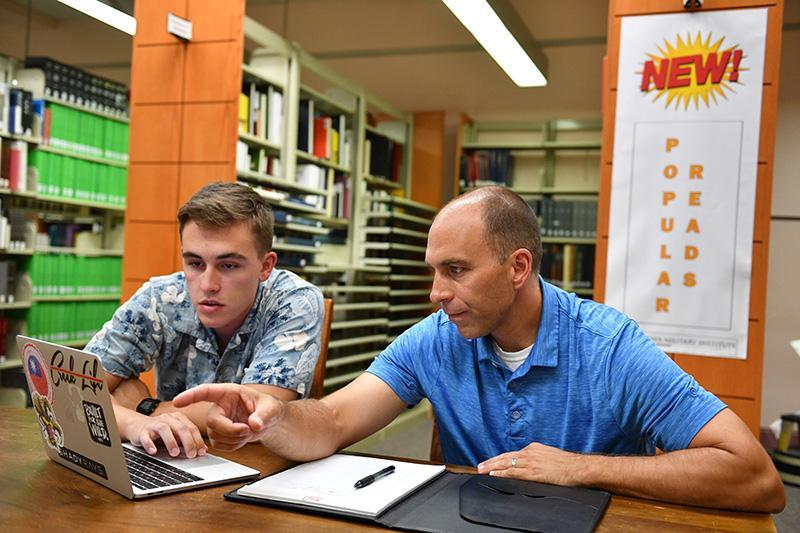Healthcare SURIs Explore Cost Savings, Security

Tristan Howard ’20 and Col. Barry Cobb discuss Howard’s research on staffing needs for nurses at the University of Virginia Healthcare System.—VMI Photo by Mary Price.
LEXINGTON, Va., June 13, 2019—This summer, two cadets are working on projects that have the potential to save money for healthcare systems.
Both Tristan Howard ’20, an economics and business major, and Alex Feldner ’21, a computer and information sciences major, are conducting their research under the auspices of the Summer Undergraduate Research Institute (SURI), which is supported by the VMI Center for Undergraduate Research (VCUR).
With a longstanding interest in healthcare, plus service as an EMT for Company C, Howard knew that he’d like to write an honors thesis on a healthcare-related topic, and he also knew that a SURI project would be the ideal springboard for a thesis.
In the spring of 2019, Howard undertook an independent study under the guidance of Col. Barry Cobb, professor of economics and business, and that’s where he found his topic: predicting the patient load, plus the nursing staff needed to care for those patients, at the University of Virginia Healthcare Center’s 17-bed pediatric intensive care unit (PICU).
The first part of Howard’s work involved much number crunching and statistical analysis. “I put together 10 different forecasting models to see which ones were the most accurate, and I used three different error measurements,” he explained.
In the end, Howard found good guidance from a paper that he’d read during the independent study. The paper said that the best way to utilize forecasting models is to average them all.
“We went through, did our 10 [forecasting models], took the top four most accurate ones, averaged them, and that was more accurate than any of them,” Howard stated.
“It’s not a lot different than forecasting the demand for some other consumer product,” noted Cobb. “We don’t know, exactly, of course … we try to estimate what the error might be in the forecast.”
The next step for Howard will be estimating how many nurses will be needed to take care of patients. But it’s a much more complex calculation than just estimating one nurse for every so many beds.
Nurses, Howard explained, do much more than provide hands-on patient care. They ensure that medications are ordered and ready when needed, confer with physicians, and document each patient’s care with meticulous accuracy. And when planning for staffing, it’s also vital to take into account that a 12-hour shift doesn’t translate into 12 hours of work. There are breaks for meals, plus the interruptions that come with every job.
“That’s the level of stuff we’re trying to get into these models,” said Howard. “The nurses do a ton of work, but we need to see how much work they actually do.”
This summer, while he’s not working on his SURI project, Howard can be found at the Lexington Fire Department, where he serves as a firefighter/EMT. After VMI, he hopes to work in Chesterfield, Virginia, as an EMT.
Feldner, meanwhile, is working to enhance the security of mobile healthcare applications for smartphones. These applications, which allow patients to request medication refills and interact with physicians, can save money and time, but privacy concerns keep many people from using them.
“People know that using such a system is pretty easy, convenient, and cheaper,” said Dr. Youna Jung, assistant professor of computer and information sciences, who is overseeing Feldner’s research. “The reason they keep hesitating to use it is because of privacy.”
Feldner explained that there are three issues related to healthcare applications in general: authenticity, or making sure users are who they say they are; data security, and network security.
There are existing solutions, though, for these challenges. The use of strong passwords and two-factor authentication is meant to ensure authenticity. Encrypting data can enhance data security, and the use of firewalls can likewise boost network security.
There are two problems specific to mobile applications, though—data retention and the usage of personal identifying information. Feldner’s task for the remainder of the summer is to find solutions to those.
He envisions being able to make suggestions to software developers. “What kinds of things must they consider to protect the privacy of patients?” he asked.
It’s easy to think that solutions which work for desktop and laptop computers could work for phones, noted Jung, but since computers and phones use different operating systems, that won’t work.
“A mobile system has a different framework,” said Jung, who is assistant professor of computer and information sciences. “We cannot apply existing methods to mobile healthcare applications.”
If the security and privacy challenges can be addressed, Feldner sees great possibilities for their use by mental health patients, who are often reluctant to seek care in the first place.
In an ideal world, he said, “any mental health patient can access these mobile apps and be able get treatment and diagnosis without feeling like their information or privacy is being misused.”
-Mary Price
-VMI-
.svg)
.png)